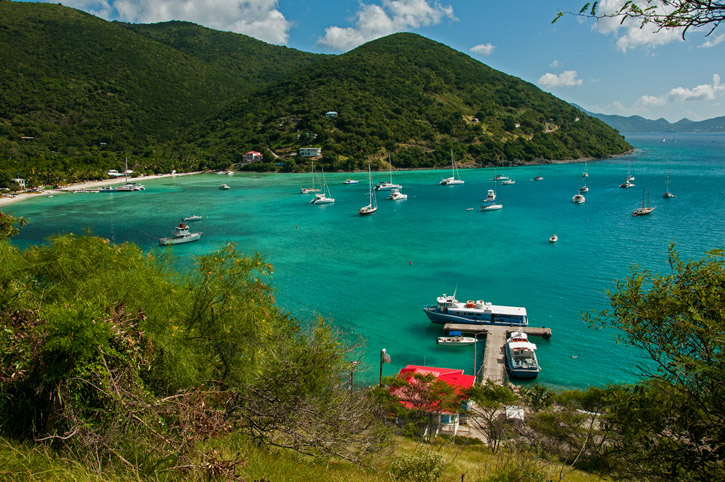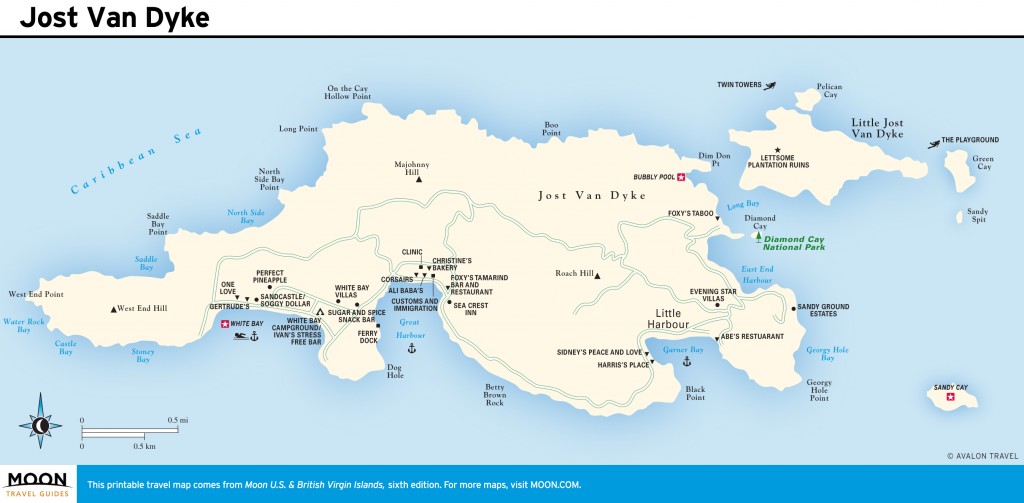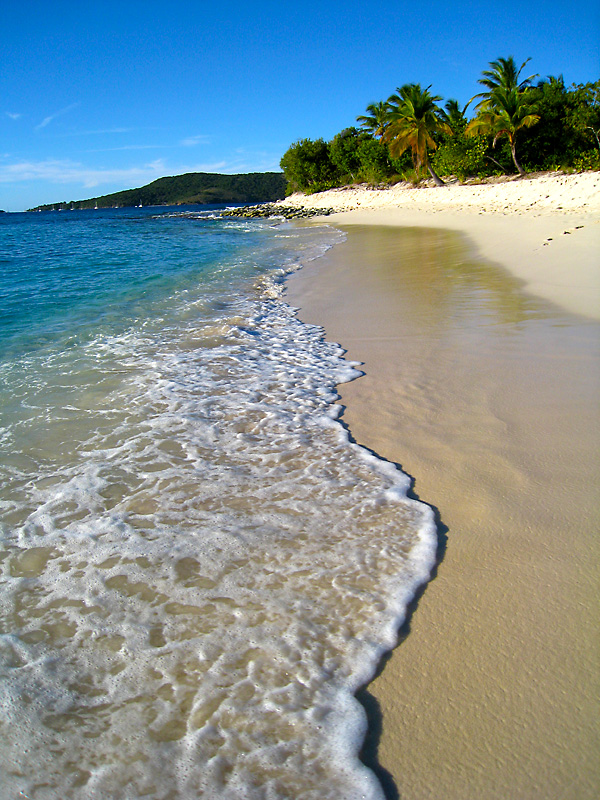Jost Van Dyke is four miles long and three miles wide at its broadest point. Its ridge climbs to 1,054 feet at Majohnney Point and stretches from east to west like a meandering backbone. Development is limited to four bays along the southwestern coast of the island, although a few hilltop homes have now been built. A single road connects White Bay, Great Harbour, Little Harbour, and the east end; it takes about 15 minutes to drive the four miles from end to end. A new road has been cut along the ridge. It is mostly unpaved and treacherous without four-wheel drive.

Whether you arrive by ferry or private boat, your first real glimpse of Jost Van Dyke will probably be of Great Harbour. Photo © bvi4092, licensed Creative Commons Attribution.
Ferries arrive at Dog Hole, on the far western end of Great Harbour. It is easy to walk from the ferry to any place in Great Harbour, and as long as you don’t mind a bit of exercise, you can walk from there to White Bay as well.

Jost Van Dyke
The eastern end of White Bay is quiet; a campground huddles among the sea grape trees and a few tasteful guesthouses look down from the hillside above. The western end is home to a half dozen beach bars and restaurants and a small hotel. The only real nod to commercialism here is at the far western tip of the beach, where on some days small cruise ships unload hundreds of passengers for a beach picnic. A sports center there rents kayaks, pedal boats, and other water toys and takes visitors on ATV tours of the island. The good news is that if this type of thing doesn’t appeal to you, it’s pretty easy to ignore.
Ask at Foxy’s Taboo for a map to the Bubbly Pool, or just head northward from the restaurant and look for the path—it’s not hard to find. You will bypass the salt pond and climb over a low rise before descending into the cove where you will find the pool. The Bubbly Pool is a small grotto formed by rocks and faced by a half-moon beach of coarse sand and rubble. The pool is large enough to fit about four swimmers comfortably. When the sea is calm, the pool is a private and quiet place for a dip. But when the northern swell is up and waves crash violently on the north-facing rocks, the show begins. On these days, large waves crash into the pool, dissipating into mounds of bubbles that crack and pop. It’s fun to play in the waves, and the bubbles have been likened to a high-priced spa treatment.
From the pool you can clamber up a short footpath on the eastern side of the pool that leads to an overlook and views of Jost Van Dyke’s rugged north coast—a landscape of sheer cliffs, pounding waves, and windswept vegetation.
The hike from Foxy’s Taboo to the Bubbly Pool takes about 20 minutes and passes loblolly trees, mangroves, and a large number of Turk’s head cacti. It’s best to wear sturdy shoes.

Relax on Sandy Cay’s white beach, snorkel on the reef, or hike the loop trail and look for bananaquits and boobies. Photo © Latham Jenkins, licensed Creative Commons Attribution No-Derivatives.
Sandy Cay, a six-acre island less than a mile offshore Jost Van Dyke, is in many respects a perfect desert island. It has a sandy white beach, coconut palm trees, a nice offshore reef, and a wooded interior. Most visitors can pass a few hours here relaxing on the beach, swimming, or snorkeling. Others take the 20-minute hike that circles the interior salt pond and traverses rocky cliffs favored by nesting seabirds. Naturalists will admire the diversity of ecosystems—beach, swamp, cliff, forest—that exist on such a tiny island. Look for the flowering lilies that grow near the beach and the seeming millions of hermit crabs that maneuver around the island in borrowed shells. Keep your eyes out for a glimpse of the tiny bananaquit, a yellow-breasted bird that flits around with great speed and favors the organ pipe cactus, especially when it is flowering. If you can’t see the birds, look for their nests, untidy masses of twigs and grass that hang just about at eye level in parts of the forest.
For many decades, Sandy Cay was owned by multimillionaire philanthropist Laurance Rockefeller. Just before his death in 2005, Rockefeller donated the island to the British Virgin Islands government on the condition that it become a national park, which it has. Rockefeller always believed in maintaining public access to the island, and the short trail that circles the island is well maintained. There are no moorings, however, and no trash cans, picnic tables, or bathrooms. Visiting sailboats should anchor off the sandy beach. The beach is susceptible to swells, especially in winter.
Excerpted from the Sixth Edition of Moon U.S. & British Virgin Islands.